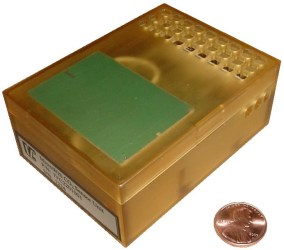Historical

MicroWIS-CO2 is a wireless data acquisition system for near-static sensing and recordingapplications. The system was developed for NASA to provide wireless carbon dioxide measurements inside NEEMO (NASA Extreme Environment Operations), an undersea astronaut training facility. It was also developed for possible use in the International Space Station (ISS) for monitoring carbon dioxide concentrations throughout the crew habitable modules.
The MicroWIS-CO2 Remote Unit (pictured)is a small, extremely low-power, autonomous, wireless device designed for extended data acquisition and recording. The sensor element uses a Non-Dispersive Infrared Diffusion (NDIR) method for measurement. Carbon dioxide diffuses into the sensor’s optical chamber where the carbon dioxide molecules absorb the infrared light that is present. This absorption is measured to derive the carbon dioxide concentration.
The NDIR transducer requires a warm-up time of at least two minutes. For greater accuracy the user has an optional warm-up time of 10 minutes.
There are three modes of data transfer:
1. A unit transmits its data in real-time to the Receiver allowing for both error detection and retransmissions. The Receiver passes this information to the GUI for immediate graphical display and storage to an ASCII file.
2. A unit stores its data in non-volatile memory for later downloading via RF to a Receiver and GUI for graphical display and storage on the PC.
3. A combination of modes 1 and 2 above; the unit transmits the information in real-time while storing the data locally.
- Sample Rates: One sample per 15min, 30min, 1hr, or 2 hr*
- Accuracy: ±200ppm or 5% of reading, which ever is greater
- Battery Lifetime:
- 166 Days at 1 sample per hour and 2 min warm-up
- 34 Days at 1 sample per hour and 10 min warm-up
- Approximate Size: 3.5cm x 6.4cm x 8.6cm
* A test mode allows for a sample rate of once every two seconds
